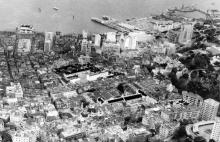24 Mar 1942, Chronology of Events Related to Stanley Civilian Internment Camp
Primary tabs
Note:
R. E. Jones’s reference to the beach being searched for mines seems to refer to this incident, described in Midge Gillies’ book The Barbed-Wire University. Gillies’s source dates it to sometime after the Argyle Street Camp was opened for officers in April 1942, but it’s hard to believe that Wakefield tried the same trick again on another of the beaches close to the Camp. And the earlier 'delivery' referred to seems to be a solo effort, while Jones's reference to three Royal Engineers and a Japanese escort seems exactly right. If I’m correct, Wakefield was delivering letters from Shamshuipo, where he’d been sent after the surrender.
Some of the women in Stanley had husbands or relatives who’d joined the Volunteers and been interned in one of the Hong Kong POW camps. Communication between Stanley and these men was hard, much to the distress of all concerned.
Royal Engineer James Wakefield was instructed by his officers, following Japanese orders, to clear up some mines he’d previously been responsible for laying. He did so, while hiding pieces of their mechanism and smuggling them back to camp.
Wakefield managed to convince the Japanese he’d laid mines at Stanley Fort, and, as he drove through Stanley Camp, he dropped several letters from POWs to loved ones at the feet of a group of internees (he was sitting at the back of a Japanese covered wagon). On his return from the operation, he was able to take back some replies to these letters.
He decided to repeat this procedure by claiming to have laid mines at ‘the beach near the old prison officers’ quarters’. He took two ‘sappers’ (privates in the Royal Engineers) with him. When they and their Japanese guards arrived at the beach they were confronted by a group of internees, led by Franklin Gimson.
Gimson insisted that, ‘There are no mines here, never have been mines here’. Wakefield tried to convey the message to Gimson with pointed looks, but to no avail – ‘There’s nothing there’.
By this point the Japanese were getting suspicious and Wakefield’s party was in some personal danger, so he said, ‘I’m not going to argue with you’ and went down to the beach. Luckily he’d brought with him the pieces of mechanism he’d kept after his genuine mine clearance, and, although the Japanese were ‘very suspicious’ he managed to get away with it (it’s not recorded if he was also able to make a second delivery of letters).
The British Communal Council puts up a notice promulgating a Japanese decree that in future all business with the authorities is to be handled through the chairmen of the American, British and Dutch communities. The decree was issued by T. Yamashita and the notice is signed by BCC member L. R. Nielson.
Sources:
Midge Gillies, The Barbed-Wire University, 2011, 218-219
Jim Shepherd, Silks, Satins, Gold Braid and Monkey Jackets, 1996, 6

